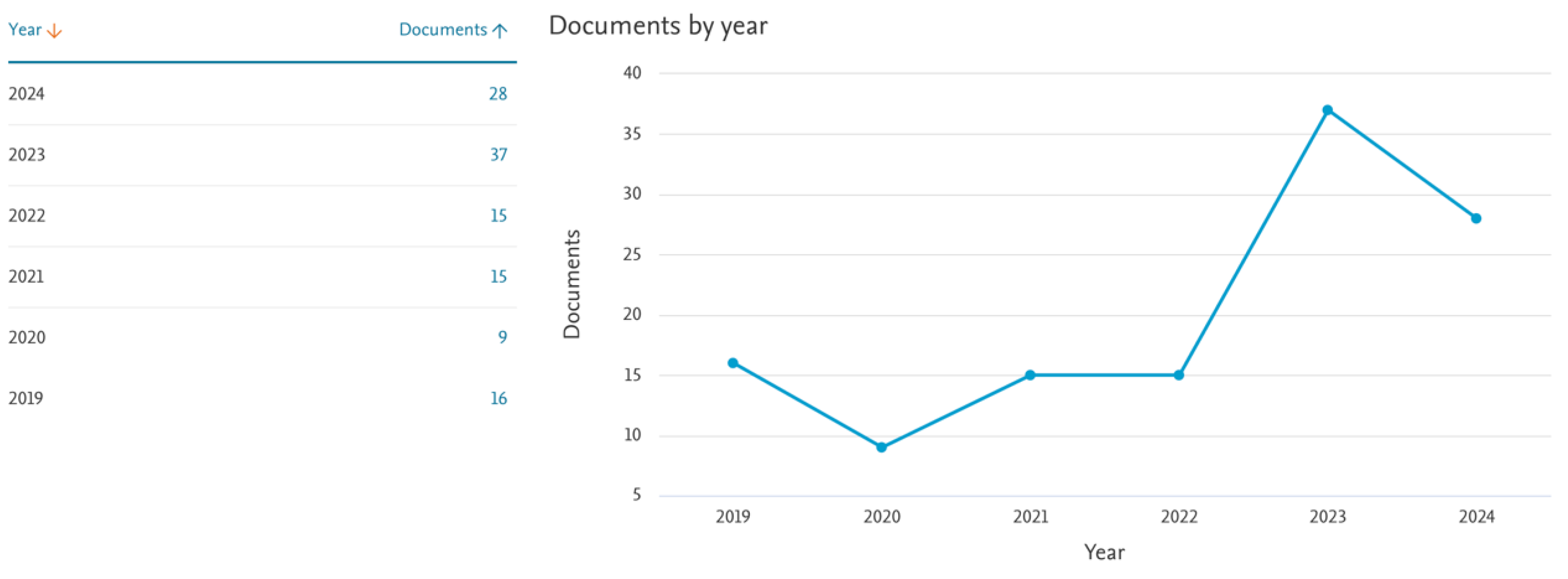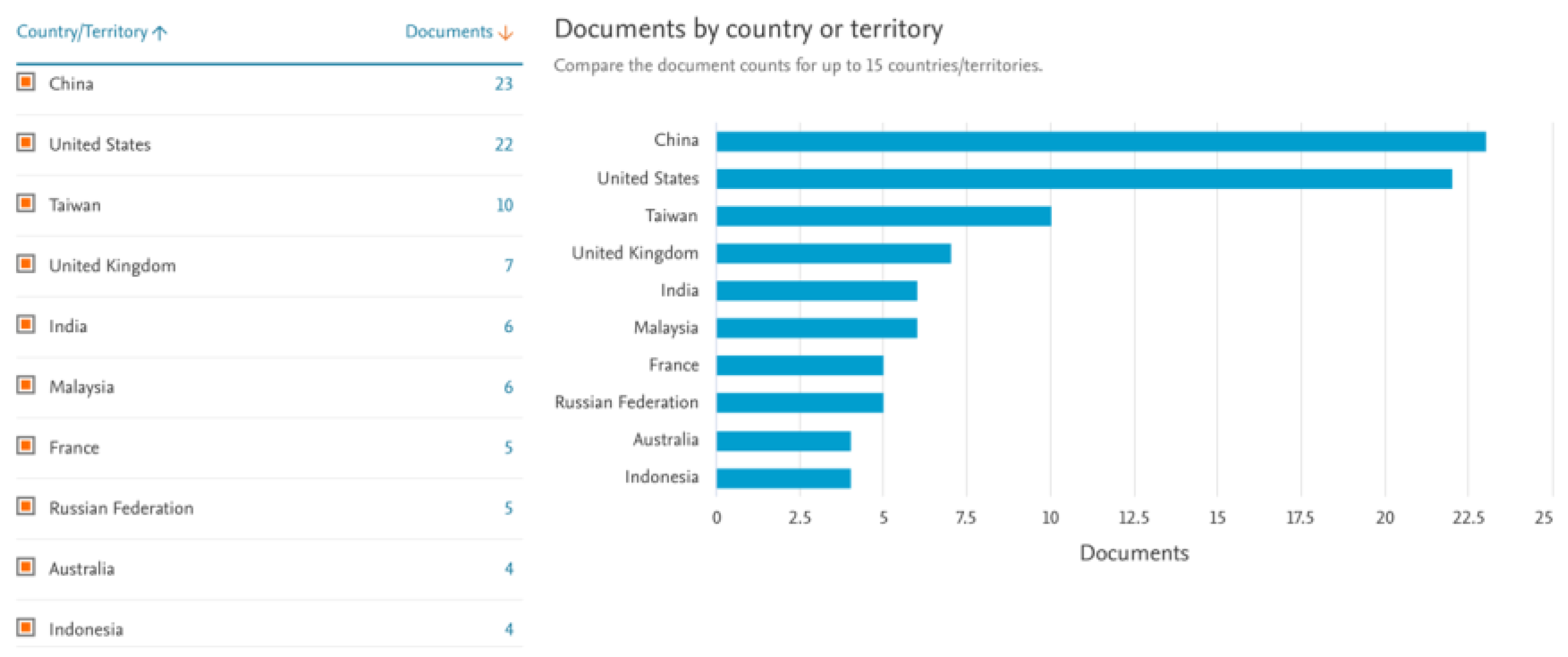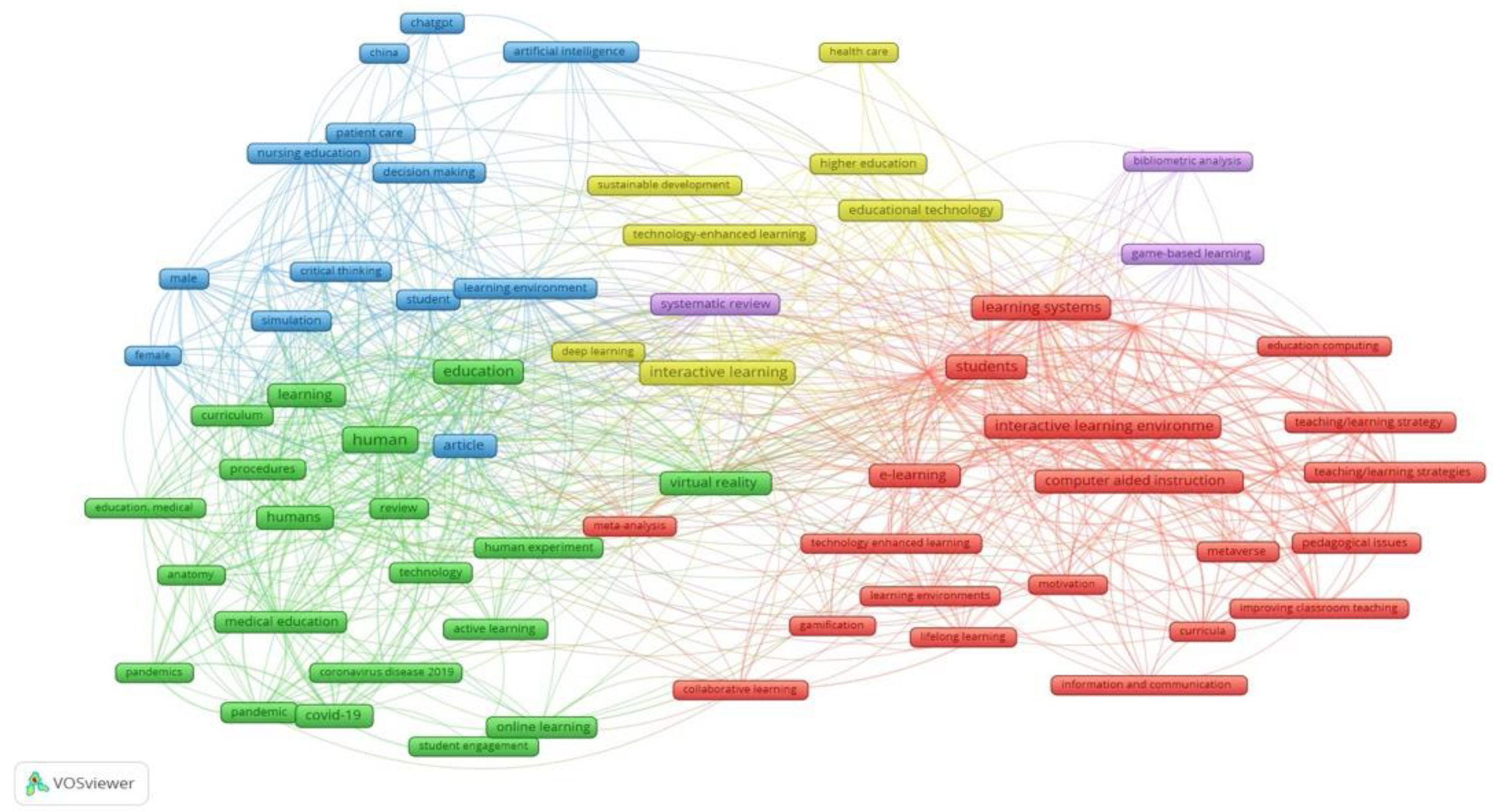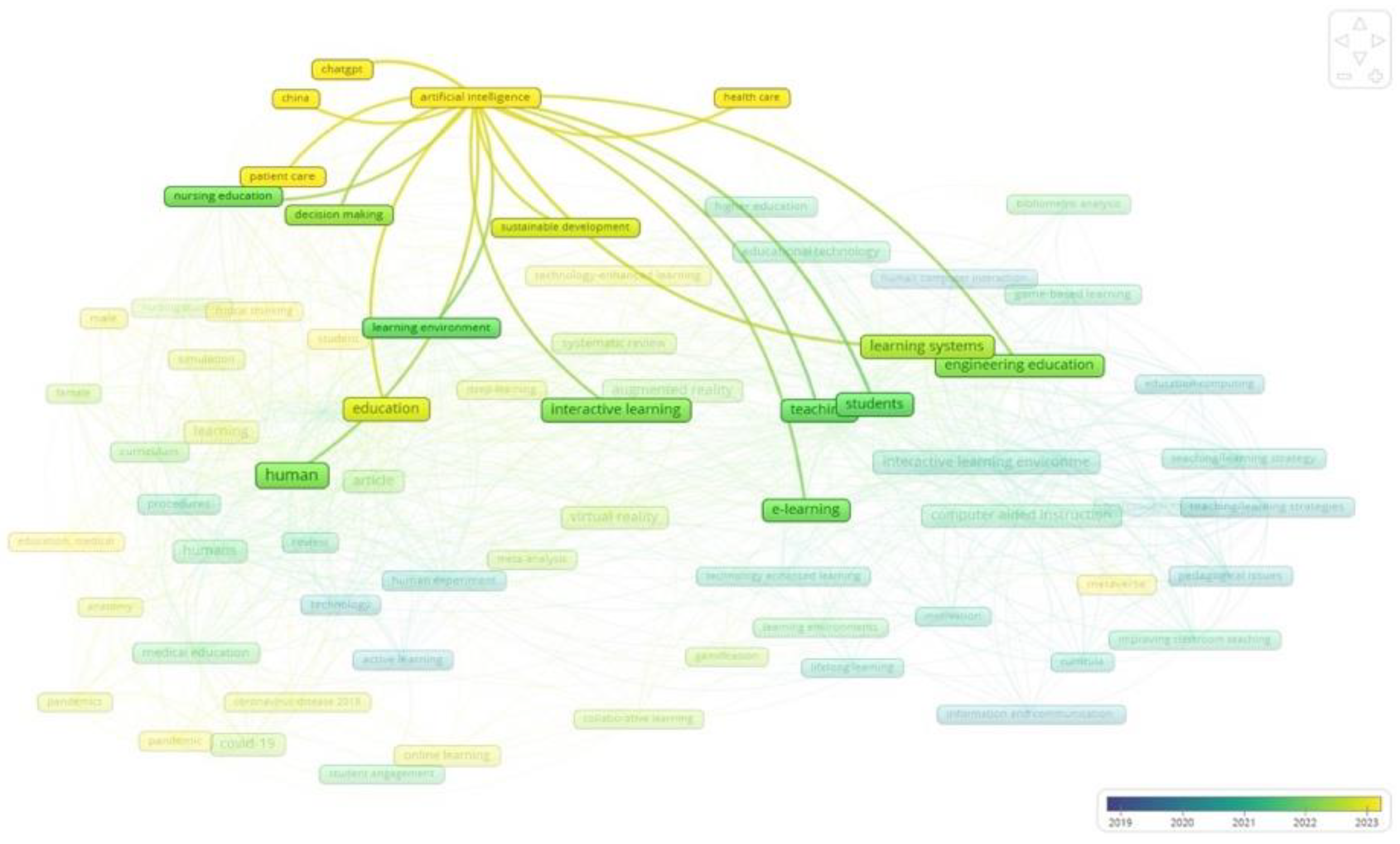The Future of Artificial Intelligence in Interactive Learning: Trends, Challenges, Opportunities †
Abstract
1. Introduction
2. Literature Review
2.1. Relevant Recent Research Findings
2.2. Research Framework and Filling Gaps in Previous Research
3. Methods
4. Analysis and Discussion
4.1. Trends and Patterns Based on the Year
4.2. Trends and Patterns Based on the Country
4.3. Trends and Patterns Based on the Subject
4.4. Cluster-Based Analysis from Network Visualization
4.5. Analysis of the Potential of AI and Interactive Learning Topics in the Next 20 Years
5. Conclusions
Author Contributions
Funding
Institutional Review Board Statement
Informed Consent Statement
Data Availability Statement
Conflicts of Interest
References
- Abbas, N.; Ali, I.; Manzoor, R.; Hussain, T.; AL Hussain, M.H. Role of Artificial Intelligence Tools in Enhancing Students’ Educational Performance at Higher Levels. August–September 2023. Available online: https://api.semanticscholar.org/CorpusID:260999551 (accessed on 10 December 2024).
- Aggarwal, D.; Sharma, D.; Saxena, A.B. Adoption of Artificial Intelligence (AI) For Development of Smart Education as the Future of a Sustainable Education System. J. Artif. Intell. Mach. Learn. Neural Netw. 2023, 2023, 23–28. [Google Scholar] [CrossRef]
- Almousa, O.; Zhang, R.; Dimma, M.; Yao, J.; Allen, A.; Chen, L.; Heidari, P.; Qayumi, K.A. Virtual Reality Technology and Remote Digital Application for Tele-Simulation and Global Medical Education: An Innovative Hybrid System for Clinical Training. Simul. Gaming 2021, 52, 614–634. Available online: https://api.semanticscholar.org/CorpusID:235517731 (accessed on 10 December 2024). [CrossRef]
- Amin, M.Y.M. AI and Chat GPT in Language Teaching: Enhancing EFL Classroom Support and Transforming Assessment Techniques. Int. J. High. Educ. Pedagog. 2023, 4, 1–15. Available online: https://api.semanticscholar.org/CorpusID:266555445 (accessed on 10 December 2024). [CrossRef]
- Ansor, F.; Zulkifli, N.A.; Jannah, D.S.M.; Krisnaresanti, A. Adaptive Learning Based on Artificial Intelligence to Overcome Student Academic Inequalities. J. Soc. Sci. Util. Technol. 2023, 1, 112–123. Available online: https://api.semanticscholar.org/CorpusID:266556478 (accessed on 10 December 2024).
- Bujdosó, G.; Novac, O.C.; Szimkovics, T. Developing cognitive processes for improving inventive thinking in system development using a collaborative virtual reality system. In Proceedings of the 2017 8th IEEE International Conference on Cognitive Infocommunications (CogInfoCom), Debrecen, Hungary, 11–14 September 2017; pp. 79–84. Available online: https://api.semanticscholar.org/CorpusID:22565943 (accessed on 7 December 2024).
- Chang, D.H.; Lin, M.P.-C.; Hajian, S.; Wang, Q.Q. Educational Design Principles of Using AI Chatbot That Supports Self-Regulated Learning in Education: Goal Setting, Feedback, and Personalization. Sustainability 2023, 15, 12921. Available online: https://api.semanticscholar.org/CorpusID:261313757 (accessed on 10 December 2024). [CrossRef]
- Chen, L.; Chen, P.; Lin, Z. Artificial Intelligence in Education: A Review. IEEE Access 2020, 8, 75264–75278. Available online: https://api.semanticscholar.org/CorpusID:218493891 (accessed on 9 December 2024). [CrossRef]
- Cheng, Y.-H. Improving Students’ Academic Performance with AI and Semantic Technologies. 2022. Available online: https://api.semanticscholar.org/CorpusID:249431920 (accessed on 10 December 2024).
- Cristea, A.I.; Ghali, F. Towards adaptation in e-learning 2.0. New Rev. Hypermedia Multimed. 2011, 17, 199–238. Available online: https://api.semanticscholar.org/CorpusID:6856062 (accessed on 10 December 2024). [CrossRef]
- du Boulay, J.B. Artificial Intelligence as an Effective Classroom Assistant. IEEE Intell. Syst. 2016, 31, 76–81. Available online: https://api.semanticscholar.org/CorpusID:5767346 (accessed on 10 December 2024). [CrossRef]
- Essa, S.G.; Çelik, T.; Human-Hendricks, N. Personalized Adaptive Learning Technologies Based on Machine Learning Techniques to Identify Learning Styles: A Systematic Literature Review. IEEE Access 2023, 11, 48392–48409. Available online: https://api.semanticscholar.org/CorpusID:258733040 (accessed on 8 December 2024). [CrossRef]
- Fidan, M.; Gencel, N. Supporting the Instructional Videos With Chatbot and Peer Feedback Mechanisms in Online Learning: The Effects on Learning Performance and Intrinsic Motivation. J. Educ. Comput. Res. 2022, 60, 1716–1741. [Google Scholar] [CrossRef]
- Ghory, S.; Ghafory, H. The Impact of Modern Technology in the Teaching and Learning Process. 2021. Available online: https://api.semanticscholar.org/CorpusID:237379604 (accessed on 10 December 2024).
- Gligorea, I.; Cioca, M.; Oancea, R.; Gorski, A.T.; Gorski, H.; Tudorache, P. Adaptive Learning Using Artificial Intelligence in e-Learning: A Literature Review. Educ. Sci. 2023, 13, 1216. Available online: https://api.semanticscholar.org/CorpusID:266076086 (accessed on 8 December 2024). [CrossRef]
- Hamal, O.; El Faddouli, N.; Harouni, M.H.A.; Lu, J. Artificial Intelligent in Education. Sustainability 2022. Available online: https://api.semanticscholar.org/CorpusID:247353273 (accessed on 10 December 2024).
- Hamdani, S.A.; Prima, E.C.; Agustin, R.R.; Feranie, S.; Sugiana, A. Development of Android-based Interactive Multimedia to Enhance Critical Thinking Skills in Learning Matters. J. Sci. Learn. 2022, 5, 103–114. Available online: https://api.semanticscholar.org/CorpusID:247350913 (accessed on 10 December 2024).
- Hashim SH, A.; Omar, M.K.; Jalil, H.A.; Sharef, N.M. Trends on Technologies and Artificial Intelligence in Education for Personalized Learning: Systematic Literature Review. Int. J. Acad. Res. Progress. Educ. Dev. 2022, 11, 884–903. Available online: https://api.semanticscholar.org/CorpusID:247333193 (accessed on 10 December 2024).
- Hawanti, S.; Zubaydulloevna, K.M. AI chatbot-based learning: Alleviating students’ anxiety in english writing classroom. Bull. Soc. Inform. Theory Appl. 2023, 7, 182–192. Available online: https://api.semanticscholar.org/CorpusID:265794128 (accessed on 7 December 2024).
- Hodhod, R.A.; Fleenor, H.; Nabi, S. Adaptive Augmented Reality Serious Game to Foster Problem Solving Skills. In Proceedings of the Australasian Conference on Interactive Entertainment, Newcastle, NSW, Australia, 2–3 December 2014; Available online: https://api.semanticscholar.org/CorpusID:7409168 (accessed on 7 December 2024).
- Hooshyar, D.; Pedaste, M.; Yang, Y.; Malva, L.; Hwang, G.; Wang, M.; Lim, H.; Delev, D. From Gaming to Computational Thinking: An Adaptive Educational Computer Game-Based Learning Approach. J. Educ. Comput. Res. 2020, 59, 383–409. Available online: https://api.semanticscholar.org/CorpusID:226333128 (accessed on 7 December 2024). [CrossRef]
- Huang, L. Ethics of Artificial Intelligence in Education: Student Privacy and Data Protection. Sci. Insights Educ. Front. 2023, 16, 2577–2587. Available online: https://api.semanticscholar.org/CorpusID:259603639 (accessed on 7 December 2024).
- Hyttinen, K. Human-centered design model in the development of online learning tools for international security training CASE IECEU New Media based Learning Application (NMLA). In Proceedings of the IC3K 2017-Proceedings of the 9th International Joint Conference on Knowledge Discovery, Knowledge Engineering and Knowledge Management, Funchal, Portugal, 1–3 November 2017; Volume 3, pp. 275–282. [Google Scholar] [CrossRef]
- Ilieva, G.; Yankova, T.; Klisarova-Belcheva, S.; Dimitrov, A.; Bratkov, M.; Angelov, D. Effects of Generative Chatbots in Higher Education. Information 2023, 14, 492. Available online: https://api.semanticscholar.org/CorpusID:261644305 (accessed on 10 December 2024). [CrossRef]
- Irfana, S.; Hardyanto, W.; Wahyuni, S. The Effectiveness of STEM-Based Android-Based Learning Media on Students’ Critical Thinking Skills. Phys. Commun. 2022, 6, 12–17. Available online: https://api.semanticscholar.org/CorpusID:254318335 (accessed on 10 December 2024).
- Shi, J.-J. Research on Control Model of Content Adaptation System. IEEE Softw 2013. Available online: https://api.semanticscholar.org/CorpusID:58860666 (accessed on 10 December 2024).
- Adnan, K.; Fahimullah, F.; Farrukh, U.; Askari, H.; Siddiqui, S.; Jameel, R.A. AI-enabled virtual reality systems for dental education. Int. J. Health Sci. 2023, 7, 1378–1392. Available online: https://api.semanticscholar.org/CorpusID:259391427 (accessed on 10 December 2024).
- Kim, W.H.; Kim, J.-H. Individualized AI Tutor Based on Developmental Learning Networks. IEEE Access 2020, 8, 27927–27937. Available online: https://api.semanticscholar.org/CorpusID:211207842 (accessed on 10 December 2024).
- Kiong, J.F. The Impact of Technology on Education: A Case Study of Schools. J. Educ. Rev. Provis. 2023, 2, 43–47. Available online: https://api.semanticscholar.org/CorpusID:257356151 (accessed on 10 December 2024).
- Kyaw, B.M.; Saxena, N.; Posadzki, P.P.; Vseteckova, J.; Nikolaou, C.K.; George, P.P.; Divakar, U.; Masiello, I.; Kononowicz, A.A.; Zary, N.; et al. Virtual Reality for Health Professions Education: Systematic Review and Meta-Analysis by the Digital Health Education Collaboration. J. Med. Internet Res. 2019, 21, e12959. Available online: https://api.semanticscholar.org/CorpusID:58947061 (accessed on 10 December 2024). [PubMed]
- Lampropoulos, G.; Keramopoulos, E.; Diamantaras, K.; Evangelidis, G. Augmented Reality and Gamification in Education: A Systematic Literature Review of Research, Applications, and Empirical Studies. Appl. Sci. 2022, 12, 6809. Available online: https://api.semanticscholar.org/CorpusID:250322994 (accessed on 10 December 2024). [CrossRef]
- Lin, Y.-S.; Chen, S.-Y.; Tsai, C.-W.; Lai, Y.-H. Exploring Computational Thinking Skills Training Through Augmented Reality and AIoT Learning. Front. Psychol. 2021, 12, 640115. Available online: https://api.semanticscholar.org/CorpusID:231991812 (accessed on 10 December 2024).
- Luan, H.; Géczy, P.; Lai, H.; Gobert, J.D.; Yang, S.J.H.; Ogata, H.; Baltes, J.; da Silva Guerra, R.; Li, P.; Tsai, C.-C. Challenges and Future Directions of Big Data and Artificial Intelligence in Education. Front. Psychol. 2020, 11, 580820. Available online: https://api.semanticscholar.org/CorpusID:224274624 (accessed on 9 December 2024).
- Mageira, K.; Pittou, D.; Papasalouros, A.; Kotis, K.I.; Zangogianni, P.; Daradoumis, A. Educational AI Chatbots for Content and Language Integrated Learning. Appl. Sci. 2022, 12, 3239. Available online: https://api.semanticscholar.org/CorpusID:247639609 (accessed on 9 December 2024). [CrossRef]
- Mao, R.Q.; Lan, L.; Kay, J.; Lohre, R.; Ayeni, O.R.; Goel, D.P.; de Sa, D. Immersive Virtual Reality for Surgical Training: A Systematic Review. J. Surg. Res. 2021, 268, 40–58. Available online: https://api.semanticscholar.org/CorpusID:236158203 (accessed on 9 December 2024).
- Marfuah, L.; Franita, Y.; Hendrastuti, Z.R. Development of flash-based learning media to improve critical thinking ability of grade VII middle school students. Union Sci. J. Math. Educ. 2023, 11, 191–199. Available online: https://api.semanticscholar.org/CorpusID:260402734 (accessed on 10 December 2024).
- Mergen, M.; Junga, A.; Risse, B.; Valkov, D.; Graf, N.; Marschall, B. Immersive training of clinical decision making with AI driven virtual patients—A new VR platform called medical. GMS J. Med. Educ. 2023, 40, DOC18. Available online: https://api.semanticscholar.org/CorpusID:259231036 (accessed on 10 December 2024).
- Neo, M. Developing a collaborative learning environment using a web-based design. J. Comput. Assists. Learn. 2003, 19, 462–473. Available online: https://api.semanticscholar.org/CorpusID:35978800 (accessed on 10 December 2024).
- Papakostas, C.; Troussas, C.; Krouska, A.; Sgouropoulou, C. Personalization of the Learning Path within an Augmented Reality Spatial Ability Training Application Based on Fuzzy Weights. Sensors 2022, 22, 7059. [Google Scholar] [CrossRef]
- Pardamean, B.; Suparyanto, T.; Cenggoro, T.W.; Sudigyo, D.; Anugrahana, A. AI-Based Learning Style Prediction in Online Learning for Primary Education. IEEE Access 2022, 10, 35725–35735. Available online: https://api.semanticscholar.org/CorpusID:247502527 (accessed on 10 December 2024).
- Rourke, S. How does virtual reality simulation compare to simulated practice in the acquisition of clinical psychomotor skills for pre-registration student nurses? A systematic review. Int. J. Nurs. Stud. 2019, 102, 103466. Available online: https://api.semanticscholar.org/CorpusID:208498030 (accessed on 10 December 2024).
- Saadé, R.G.; Morin, D.; Thomas, J.D.E. Critical thinking in E-learning environments. Comput. Hum. Behav. 2012, 28, 1608–1617. Available online: https://api.semanticscholar.org/CorpusID:18244543 (accessed on 10 December 2024).
- Sethi, K.; Sharma, A.; Chauhan, S.S.; Jaiswal, V. Impact of Social and Cultural Challenges in Education Using AI. 2020. Available online: https://api.semanticscholar.org/CorpusID:204640695 (accessed on 10 December 2024).
- Shankar, D.A.U.; Tewari, D.V.; Rahman, M.; Mishra, D.A.; Bajaj, M.K.K. Impact of Virtual Reality (Vr) and Augmented Reality (Ar) in Education. Tuijin Jishu/J. Propuls. Technol. 2023. Available online: https://api.semanticscholar.org/CorpusID:264444247 (accessed on 10 December 2024).
- Shen, C.; Shi, P.; Guo, J.; Xu, S.; Tian, J. From process to product: Writing engagement and performance of EFL learners under computer-generated feedback instruction. Front. Psychol. 2023, 14. Available online: https://api.semanticscholar.org/CorpusID:264457555 (accessed on 7 December 2024).
- Syawaludin, A.; Gunarhadi, G.; Rintayati, P. Development of Augmented Reality-Based Interactive Multimedia to Improve Critical Thinking Skills in Science Learning. Int. J. Instr. 2019, 12, 331–344. Available online: https://api.semanticscholar.org/CorpusID:202717562 (accessed on 7 December 2024).
- Tapalova, O.; Zhiyenbayeva, N.; Gura, D. Artificial Intelligence in Education: AIEd for Personalised Learning Pathways. Electron. J. E-Learn. 2022, 20, 639–653. Available online: https://api.semanticscholar.org/CorpusID:254558139 (accessed on 10 December 2024).
- Vemula, S. Leveraging VR/AR/MR and AI as Innovative Educational Practices for “iGeneration” Students. 2021. Available online: https://api.semanticscholar.org/CorpusID:228868478 (accessed on 10 December 2024).
- Verner, I.; Cuperman, D.; Perez-Villalobos, H.; Polishuk, A.; Gamer, S. Augmented and Virtual Reality Experiences for Learning Robotics and Training Integrative Thinking Skills. Robotics 2022, 11, 90. [Google Scholar] [CrossRef]
- Zafari, M.; Bazargani, J.S.; Sadeghi-Niaraki, A.; Choi, S.-M. Artificial Intelligence Applications in K-12 Education: A Systematic Literature Review. IEEE Access 2022, 10, 61905–61921. Available online: https://api.semanticscholar.org/CorpusID:249213347 (accessed on 10 December 2024).
- Zeineddine, H.; Braendle, U.C.; Farah, A. Enhancing prediction of student success: Automated machine learning approach. Comput. Electr. Eng. 2021, 89, 106903. Available online: https://api.semanticscholar.org/CorpusID:229454854 (accessed on 10 December 2024).








| Cluster | Topic | Topic & Cluster Relationship | Title & Cluster Relationship |
|---|---|---|---|
| 1 (Red, 24 items) | learning systems, students, interactive learning environments, computer aided instruction, e-learning | Focus on technology integration in supporting an interactive and effective learning process. | Linking research titles on interactive learning systems and computer-aided instruction with a primary focus in clusters. |
| 2 (Green, 21 items) | education, learning, human, online learning, medical education | Exploring the use of technology to improve student learning and engagement in a variety of educational contexts. | Linking research titles on online education and learning with a primary focus in the cluster. |
| 3 (Blue, 14 items) | Artificial Intelligence, ChatGPT, Nursing Education, Critical Thinking, Simulation | The use of AI in education to improve learning and evaluation, particularly in simulation and the development of critical thinking skills | Linking research titles on AI and critical thinking skills development with a primary focus within the cluster. |
| 4 (Yellow, 10 items) | Interactive Learning, Educational Technology, Higher Education, Sustainable Development | Focus on educational technology in the context of higher education and sustainable development. | Linking research titles on educational technology in higher education and sustainable development with a primary focus in the cluster. |
| 5 (Purple, 4 items) | game-based learning, bibliometric analysis, systematic review | A meta-analytic approach to understanding the impact and trends in the use of games in an educational context. | Linking research titles on bibliometric analysis and game-based learning with a primary focus in clusters. |
Disclaimer/Publisher’s Note: The statements, opinions and data contained in all publications are solely those of the individual author(s) and contributor(s) and not of MDPI and/or the editor(s). MDPI and/or the editor(s) disclaim responsibility for any injury to people or property resulting from any ideas, methods, instructions or products referred to in the content. |
© 2025 by the authors. Licensee MDPI, Basel, Switzerland. This article is an open access article distributed under the terms and conditions of the Creative Commons Attribution (CC BY) license (https://creativecommons.org/licenses/by/4.0/).
Share and Cite
Alam, T.H.I.; Windiarti, I.S. The Future of Artificial Intelligence in Interactive Learning: Trends, Challenges, Opportunities. Eng. Proc. 2025, 84, 87. https://doi.org/10.3390/engproc2025084087
Alam THI, Windiarti IS. The Future of Artificial Intelligence in Interactive Learning: Trends, Challenges, Opportunities. Engineering Proceedings. 2025; 84(1):87. https://doi.org/10.3390/engproc2025084087
Chicago/Turabian StyleAlam, Teguh Hidayat Iskandar, and Ika Safitri Windiarti. 2025. "The Future of Artificial Intelligence in Interactive Learning: Trends, Challenges, Opportunities" Engineering Proceedings 84, no. 1: 87. https://doi.org/10.3390/engproc2025084087
APA StyleAlam, T. H. I., & Windiarti, I. S. (2025). The Future of Artificial Intelligence in Interactive Learning: Trends, Challenges, Opportunities. Engineering Proceedings, 84(1), 87. https://doi.org/10.3390/engproc2025084087






